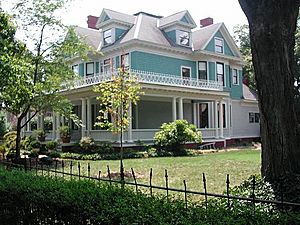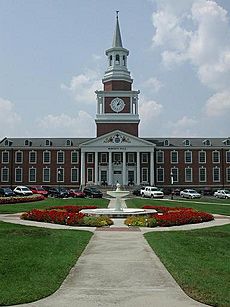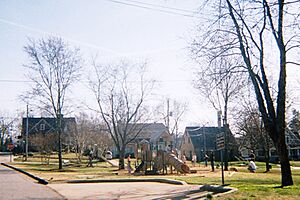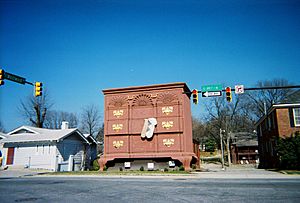High Point, North Carolina facts for kids
Quick facts for kids
High Point
|
|||||
|---|---|---|---|---|---|
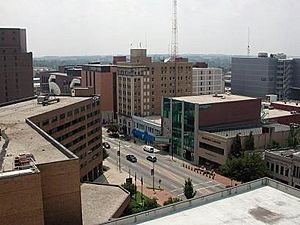
Downtown High Point
|
|||||
|
|||||
| Nickname(s):
North Carolina's International City, Home Furnishings and Hosiery Capital of the World, City of the Future, HP, Hype Point, The Pocket, The Point
|
|||||
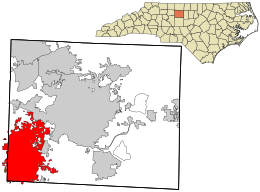
Location in Guilford County and North Carolina
|
|||||
| Country | United States | ||||
| State | North Carolina | ||||
| Counties | Guilford, Davidson, Randolph, Forsyth | ||||
| Chartered | May 26, 1859 | ||||
| Named for | Highest point of the 1856 North Carolina Railroad | ||||
| Area | |||||
| • Total | 58.43 sq mi (151.33 km2) | ||||
| • Land | 56.91 sq mi (147.39 km2) | ||||
| • Water | 1.52 sq mi (3.94 km2) 2.60% | ||||
| Elevation | 866 ft (264 m) | ||||
| Population
(2020)
|
|||||
| • Total | 114,059 | ||||
| • Estimate
(2023)
|
116,926 | ||||
| • Rank | 259th in the United States 9th in North Carolina |
||||
| • Density | 2,004.31/sq mi (773.87/km2) | ||||
| • Urban | 167,830 (US: 217th) | ||||
| • Urban density | 1,665.1/sq mi (642.9/km2) | ||||
| • Metro | 789,842 (US: 78th) | ||||
| Time zone | UTC−5 (EST) | ||||
| • Summer (DST) | UTC−4 (EDT) | ||||
| ZIP Codes |
27260–27265
|
||||
| Area code(s) | 336 | ||||
| FIPS code | 37-31400 | ||||
| GNIS feature ID | 2404696 | ||||
| Primary Airport | Piedmont Triad International Airport | ||||
| Public transportation | Piedmont Authority for Regional Transportation Hi tran |
||||
High Point is a city in the Piedmont Triad region of North Carolina, a state in the United States. It's special because it's the only city in North Carolina that stretches into four different counties: Guilford, Randolph, Davidson, and Forsyth.
In 2020, about 114,059 people lived in High Point. This makes it the ninth-largest city in North Carolina. High Point is known as "North Carolina's International City." This is because of the huge High Point Furniture Market, which brings in thousands of people from all over the world twice a year. The city is also home to High Point University, a private university founded in 1924.
Contents
- High Point's Story: A Look at its History
- Where is High Point? Geography and Location
- People of High Point: Demographics
- High Point's Economy: Industries and Jobs
- Getting Around: Transportation in High Point
- Learning in High Point: Education
- Media in High Point: News and TV
- Fun Things to Do: High Point Attractions
- Famous People from High Point
- Images for kids
- See also
High Point's Story: A Look at its History
High Point got its name because it was the highest point on the 1856 North Carolina Railroad. This railroad connected Charlotte and Goldsboro. The city was also where this railroad crossed the 1852 Great Western Plank Road. This central location and good transportation helped High Point grow quickly. It made it easy to bring in materials like cotton and wood. It also helped to ship out finished goods.
People from Europe, including English Quakers and German immigrants, settled here before 1750. However, High Point officially became a town in 1859. Before it became a big manufacturing hub, its main industries were tobacco, woodworking, and textiles. The first furniture factory in High Point opened in 1889. High Point College started in 1924. Today, it's a university with about 4,400 students from many different countries and states.
Historic Places to Explore
High Point has many important historic places. These sites are listed on the National Register of Historic Places. They help tell the story of the city's past.
Where is High Point? Geography and Location
As mentioned, High Point is unique because it's in four counties: Davidson, Forsyth, Guilford, and Randolph. The city also sits between two major river systems. To the west is the Yadkin–Pee Dee system. To the east is the Cape Fear system.
Some parts of High Point are over 1,000 feet high. This makes it one of the highest cities in North Carolina's Piedmont region. High Point is next to Greensboro to the north. It borders Jamestown to the northeast. To the southeast, it's near Archdale. The cities of Trinity and Thomasville are also very close to High Point.
The city covers about 58.43 square miles. Most of this area is land, with a small part being water.
High Point's Weather: Understanding the Climate
High Point has a humid subtropical climate. This means summers are hot and humid. Temperatures often reach the 90s Fahrenheit (30s Celsius). Sometimes, they can even go above 100°F (38°C). Nights usually stay warm, above 70°F (21°C).
Winters are cool to cold. Nighttime temperatures average around 30°F (-1°C). The coldest days might stay below freezing. The hottest temperature ever recorded was 106°F (41°C). The coldest was -7°F (-22°C).
Rainfall is spread out evenly throughout the year. The city gets about 43 inches of rain annually. Snowfall changes a lot each year. Most years, there's less than 5 inches (13 cm) of snow. However, some years can see over 20 inches (51 cm). High Point can also be affected by ice storms.
In 2010, a strong tornado hit the northern parts of the city. In 1989, Hurricane Hugo caused minor wind damage as it moved through the area.
| Climate data for High Point, North Carolina (1991–2020 normals, extremes 1926–present) | |||||||||||||
|---|---|---|---|---|---|---|---|---|---|---|---|---|---|
| Month | Jan | Feb | Mar | Apr | May | Jun | Jul | Aug | Sep | Oct | Nov | Dec | Year |
| Record high °F (°C) | 83 (28) |
85 (29) |
89 (32) |
96 (36) |
100 (38) |
105 (41) |
106 (41) |
105 (41) |
104 (40) |
94 (34) |
89 (32) |
81 (27) |
106 (41) |
| Mean daily maximum °F (°C) | 51.7 (10.9) |
56.0 (13.3) |
64.1 (17.8) |
73.7 (23.2) |
80.1 (26.7) |
86.5 (30.3) |
89.4 (31.9) |
88.0 (31.1) |
82.4 (28.0) |
73.3 (22.9) |
62.3 (16.8) |
53.8 (12.1) |
71.8 (22.1) |
| Daily mean °F (°C) | 41.7 (5.4) |
45.2 (7.3) |
52.3 (11.3) |
61.5 (16.4) |
68.8 (20.4) |
76.1 (24.5) |
79.4 (26.3) |
78.1 (25.6) |
72.2 (22.3) |
61.9 (16.6) |
51.4 (10.8) |
44.1 (6.7) |
61.1 (16.2) |
| Mean daily minimum °F (°C) | 31.6 (−0.2) |
34.3 (1.3) |
40.5 (4.7) |
49.3 (9.6) |
57.6 (14.2) |
65.7 (18.7) |
69.3 (20.7) |
68.3 (20.2) |
62.1 (16.7) |
50.4 (10.2) |
40.5 (4.7) |
34.4 (1.3) |
50.3 (10.2) |
| Record low °F (°C) | −7 (−22) |
−3 (−19) |
7 (−14) |
22 (−6) |
33 (1) |
39 (4) |
49 (9) |
41 (5) |
34 (1) |
19 (−7) |
10 (−12) |
0 (−18) |
−7 (−22) |
| Average precipitation inches (mm) | 3.83 (97) |
3.17 (81) |
4.09 (104) |
4.05 (103) |
3.76 (96) |
4.37 (111) |
4.56 (116) |
5.06 (129) |
4.79 (122) |
3.27 (83) |
3.57 (91) |
3.75 (95) |
48.27 (1,226) |
| Average snowfall inches (cm) | 1.3 (3.3) |
0.0 (0.0) |
0.1 (0.25) |
0.0 (0.0) |
0.0 (0.0) |
0.0 (0.0) |
0.0 (0.0) |
0.0 (0.0) |
0.0 (0.0) |
0.0 (0.0) |
0.0 (0.0) |
0.5 (1.3) |
1.9 (4.8) |
| Average precipitation days (≥ 0.01 in) | 10.7 | 8.9 | 10.6 | 9.8 | 10.4 | 9.8 | 11.1 | 9.9 | 8.5 | 7.7 | 8.2 | 10.7 | 116.3 |
| Average snowy days (≥ 0.1 in) | 0.2 | 0.1 | 0.1 | 0.0 | 0.0 | 0.0 | 0.0 | 0.0 | 0.0 | 0.0 | 0.0 | 0.2 | 0.6 |
| Source: NOAA | |||||||||||||
People of High Point: Demographics
| Historical population | |||
|---|---|---|---|
| Census | Pop. | %± | |
| 1860 | 525 | — | |
| 1870 | 1,627 | 209.9% | |
| 1880 | 1,991 | 22.4% | |
| 1890 | 2,500 | 25.6% | |
| 1900 | 4,163 | 66.5% | |
| 1910 | 9,525 | 128.8% | |
| 1920 | 14,302 | 50.2% | |
| 1930 | 36,745 | 156.9% | |
| 1940 | 38,495 | 4.8% | |
| 1950 | 39,973 | 3.8% | |
| 1960 | 62,063 | 55.3% | |
| 1970 | 63,229 | 1.9% | |
| 1980 | 63,380 | 0.2% | |
| 1990 | 69,428 | 9.5% | |
| 2000 | 85,839 | 23.6% | |
| 2010 | 104,371 | 21.6% | |
| 2020 | 114,059 | 9.3% | |
| 2023 (est.) | 116,926 | 12.0% | |
| U.S. Decennial Census 2020 |
|||
High Point's Population in 2020
In 2020, High Point had 114,059 residents. There were 40,877 households and 25,792 families living in the city. The city's population has grown steadily over the years.
| Race / Ethnicity (NH = Non-Hispanic) | Pop 2000 | Pop 2010 | Pop 2020 | % 2000 | % 2010 | % 2020 |
|---|---|---|---|---|---|---|
| White alone (NH) | 50,176 | 52,612 | 50,000 | 58.45% | 50.41% | 43.84% |
| Black or African American alone (NH) | 27,064 | 33,983 | 36,124 | 31.53% | 32.56% | 31.67% |
| Native American or Alaska Native alone (NH) | 349 | 436 | 403 | 0.41% | 0.42% | 0.35% |
| Asian alone (NH) | 2,847 | 6,302 | 9,985 | 3.32% | 6.04% | 8.75% |
| Pacific Islander alone (NH) | 13 | 38 | 47 | 0.02% | 0.04% | 0.04% |
| Some Other Race alone (NH) | 139 | 279 | 805 | 0.16% | 0.27% | 0.71% |
| Mixed Race or Multi-Racial (NH) | 1,054 | 1,874 | 3,911 | 1.23% | 1.80% | 3.43% |
| Hispanic or Latino (any race) | 4,197 | 8,847 | 12,784 | 4.89% | 8.48% | 11.21% |
| Total | 85,839 | 104,371 | 114,059 | 100.00% | 100.00% | 100.00% |
High Point's Economy: Industries and Jobs
High Point is famous for its furniture, textiles, and bus manufacturing. The city's economy has grown to include other areas too. These include distribution, customer service, banking, and pharmaceuticals.
The High Point Furniture Market
The High Point Furniture Market is a huge event. It's the biggest home furnishings trade show in the world! It happens twice a year, in April and October. About 70,000 to 80,000 people attend each time. The market uses over 11 million square feet of showroom space. More than 2,000 companies show their products in about 180 buildings. This market brings billions of dollars to the area's economy.
How the Furniture Industry Grew
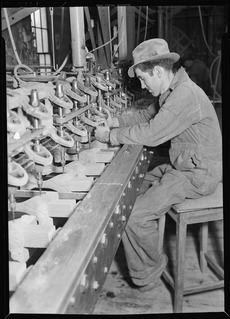
High Point became a major center for furniture making in the South. After the Civil War, there was a lot of cheap labor available. High Point was a good location because of its transportation links and nearby hardwood forests. The first furniture company, High Point Furniture Manufacturing Company, started in 1889. By 1900, 13 new furniture factories had opened in High Point.
By the early 1900s, High Point was the top furniture center in the South. Companies nearby also made things like mirrors and paint for the furniture factories. As more factories opened, competition grew. Companies like Tomlinson Chair Co. found new ways to succeed. They shared profits with workers who met goals.
Marketing became very important. Furniture was big and heavy, so store owners had to visit factories to buy it. In 1905, High Point held its first furniture exposition. This was a place for manufacturers to show their products and take orders. In 1921, a large Southern Furniture Exhibition Building was built. High Point soon became the most important furniture show site in the country.
The furniture industry helped High Point grow a lot in the 1920s and 1950s. By 1959, North Carolina had the most furniture industry workers in the U.S. High Point was known as the "Furniture Capital of the World" in the 1980s.
In the 1990s, global trade increased. Many U.S. furniture companies moved their production overseas. China became a leading manufacturer. Today, most furniture companies in North Carolina have closed. However, some local artisans still make unique, high-quality wooden furniture.
You can learn more about this history at the High Point Museum. The Bienenstock Furniture Library in downtown High Point has the world's largest collection of books on furniture history.
Top Employers in High Point
Many companies provide jobs in High Point. Here are some of the biggest employers:
| # | Employer | # of employees |
|---|---|---|
| 1 | Wake Forest Baptist Health | 3,347 |
| 2 | Ralph Lauren | 2,097 |
| 3 | Thomas Built Buses | 1,700 |
| 4 | Bank of America | 1,650 |
| 5 | Guilford County Schools | 1,643 |
| 6 | High Point University | 1,597 |
| 7 | City of High Point | 1,464 |
| 8 | Alorica | 1,450 |
| 9 | Aetna | 1,230 |
| 10 | XPO Logistics | 900 |
Getting Around: Transportation in High Point
High Point has good transportation options. Amtrak trains connect High Point to major cities like New York, Washington, and Atlanta. The historic High Point Amtrak station has been recently updated.
Major highways like Interstate 85 and Interstate 74 pass through or near the city. The Piedmont Authority for Regional Transportation (PART) offers shuttle services to other cities in the region. For local travel, High Point has Hi tran, its public bus service.
Highways that go through High Point include:
 I-74
I-74 I-85
I-85 US 29
US 29 US 70
US 70 NC 62
NC 62 NC 66
NC 66 NC 68
NC 68 NC 610
NC 610
Learning in High Point: Education
Private schools for children started in High Point as early as the 1800s. Quakers, a religious group, opened a school for African American students in 1891. This school was called the High Point Normal and Industrial School. It later became William Penn High School. Today, it is the Penn-Griffin School for the Arts, a public arts high school. It's one of three public high schools in the city.
The High Point public school system began in 1897. Over the years, many new schools were built as the city grew. High Point High School opened in 1927. It was designed with beautiful architecture. In 1962, its name changed to High Point Central High School. This happened when another high school, T. Wingate Andrews High School, was built.
High Point also has several private schools. These include High Point Christian Academy, High Point Friends School, and Westchester Country Day School. Phoenix Academy is a local charter school.
In 1921, leaders in High Point wanted to bring a college to the city. They raised money to attract the North Carolina Methodist Protestants. This group had wanted to start a college for many years. High Point offered land and money, and High Point University opened in 1924. Today, it's a four-year university offering many different majors. Guilford Technical Community College also has a campus in High Point.
Media in High Point: News and TV
Newspapers
The High Point Enterprise is the city's daily newspaper. It has been published since 1885. HP Magazine is a monthly magazine about local lifestyle, food, and history. Other free weekly papers like Triad City Beat and Yes! Weekly also cover High Point.
Television Stations
High Point is part of the Greensboro/Winston-Salem/High Point television area. Here are some of the TV stations you can watch:
- WFMY-TV, Channel 2, CBS
- WGHP, Channel 8, FOX
- WXII-TV, Channel 12, NBC
- WGPX, Channel 16, ION
- WCWG, Channel 20, CW
- WUNL-TV, Channel 26, PBS/UNCTV
- WLXI-TV, Channel 43, TCT
- WXLV-TV, Channel 45, ABC
- WMYV-TV, Channel 48, MyNetworkTV
Fun Things to Do: High Point Attractions
High Point offers many fun places to visit:
- Bernice Bienenstock Furniture Library: This library has the world's largest collection of books on furniture history.
- Castle McCulloch Gold Mill: Built in 1832, this old gold processing center is now used for special events.
- High Point City Lake Park: A park with a lake for boating and fishing. It has paddle boats, picnic areas, a historic carousel, a train, and a large outdoor swimming pool.
- High Point Community Theatre: Watch plays and musicals performed by local actors. They also offer classes for kids and adults.
- High Point Museum and Historical Park: Learn about High Point's history. See a log Blacksmith Shop and the 1786 Haley House.
- High Point Public Library: A huge library with nearly 400,000 books, music, and movies. It has special areas for youth and young adults.
- Millis Regional Health Education Center: An interactive center where you can learn about the human body and health.
- Museum of Old Domestic Life: A Quaker museum with artifacts from old colonial Quaker homes.
- Piedmont Environmental Center: Explore hiking trails next to High Point City Lake. It has a nature preserve and small animal exhibits.
- Rosetta C. Baldwin Museum: This museum shows what a typical African American home looked like in the mid-1900s.
- Sechrest Gallery: Located at High Point University, this gallery has art collections and rotating exhibits.
- Theatre Art Galleries: See exhibitions of modern visual art.
- Truist Point: A baseball park that is home to the High Point Rockers team.
- World's Largest Chest of Drawers: Built in 1926, this giant chest of drawers is a famous landmark.
Famous People from High Point
Many notable people have connections to High Point:
- Alma Adams, politician
- Bam Adebayo, NBA player for the Miami Heat
- Luke Appling, baseball player, in the Baseball Hall of Fame
- Fantasia Barrino, Grammy Award-winning singer and American Idol winner
- Heather Bergsma, Olympic speed skater
- John Coltrane, famous jazz saxophonist, grew up in High Point
- James Dickey, poet and author of Deliverance
- William Hayes, NFL defensive end
- Jenn Lyon, actress
- Bob Margolin, blues guitarist
- Wil Myers, MLB player
- Eddie Pope, professional soccer player
- Nido R. Qubein, president of High Point University
- Clyde Simms, professional soccer player
- Emily Spivey, television writer and producer
- Maxwell Thurman, U.S. Army general
- Adrian Wilson, former NFL safety
Images for kids
See also
 In Spanish: High Point (Carolina del Norte) para niños
In Spanish: High Point (Carolina del Norte) para niños






